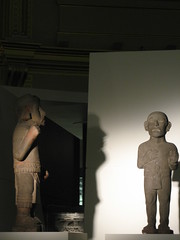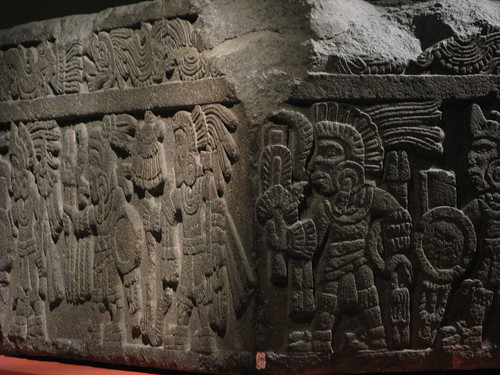And no disrespect intended to the South African President.
The clan and I went to the British Museum the other day. In its reading room, under the great rotunda, is an exhibit to the last of the Aztec kings, Moctezuma, demi-god, heap big chief Mexica. Peerless warrior and top hierarch, he was undone by his faith in his gods and the legend that Quetzalcoatl would arrive from the East to become king of the Aztecs. Thus, when Hernán Cortés appeared, shiny in his steel armour and atop an armoured horse, the Aztecs fell to their knees, gave up their gold in uncountable tons, and were crushed by the cruel Christians of Spain.
That story is well-known, of course. In Mexico, Montezuma today has the reputation of a weakling who surrendered his peoples to the invader. Post-conquest Spanish propaganda promoted the story of Moctezuma's death at the hands of his own people. Today, the argument is that the Spaniards had killed him themselves. Meanwhile, in Europe over the centuries, his fame and allure have spread. This exhibition seeks to provide a more nuanced picture of the man and his times. Walking through its aisles, it is clear that not in art and not in architecture and not in sophistication and certainly not in grandeur did the Mexicans ever play second fiddle to the conquering Spaniards.
 There are some lovely pieces on display, pulled from friendly museums in Europe and from Mexico. Here, for example, is the Ahuitzotl, a magical water-being (otter-like? canine?) that was known to pull swimmers underwater to drown them. At night, it would wail like an infant, and when someone came to the pond or the river looking for the baby, it would pull him under with the hand at the end of its tail. Days later, the body would float up to the surface, missing its eyes and nails and teeth.
There are some lovely pieces on display, pulled from friendly museums in Europe and from Mexico. Here, for example, is the Ahuitzotl, a magical water-being (otter-like? canine?) that was known to pull swimmers underwater to drown them. At night, it would wail like an infant, and when someone came to the pond or the river looking for the baby, it would pull him under with the hand at the end of its tail. Days later, the body would float up to the surface, missing its eyes and nails and teeth.
 Or take a look at these two little statuettes. The one on the left, in profile, is a standard-bearer in the garb of Xiuhtecuhtli, the Turquoise Lord and Lord of Fire; the other is a Macehual, a commoner in poor garb. Xiuhtecuhtli is considered by some to the progenitor of the Gods, but also god of fire and day and of life after death. He is thought to dwell in the turquoise centre of the earth. The Macehual is simplicity itself, wearing a loin-cloth, a hand submissively on his chest, filled with humility. The Aztec civilisation was intensely hierarchical, and the commoner knew his place in it.
Or take a look at these two little statuettes. The one on the left, in profile, is a standard-bearer in the garb of Xiuhtecuhtli, the Turquoise Lord and Lord of Fire; the other is a Macehual, a commoner in poor garb. Xiuhtecuhtli is considered by some to the progenitor of the Gods, but also god of fire and day and of life after death. He is thought to dwell in the turquoise centre of the earth. The Macehual is simplicity itself, wearing a loin-cloth, a hand submissively on his chest, filled with humility. The Aztec civilisation was intensely hierarchical, and the commoner knew his place in it.
 And, finally, check out this view of a corner of an enormous stone block, carved into reliefs of a procession of Aztec warriors. Unless I'm mistaken (and I could be, not having taken notes at the time), this is the Stone of the Warriors, discovered in Mexico City in 1897. Fully armed, the soldiers approach a symbol of sacrifice; each of the fourteen men has a distinctive head-dress, and possibly represent Tenochtitlan, the Aztec capital. Atop the sculpture used to be an earth monster, devourer of blood and hearts; now there is a depression (to support either a throne or an altar) made in colonial times.
And, finally, check out this view of a corner of an enormous stone block, carved into reliefs of a procession of Aztec warriors. Unless I'm mistaken (and I could be, not having taken notes at the time), this is the Stone of the Warriors, discovered in Mexico City in 1897. Fully armed, the soldiers approach a symbol of sacrifice; each of the fourteen men has a distinctive head-dress, and possibly represent Tenochtitlan, the Aztec capital. Atop the sculpture used to be an earth monster, devourer of blood and hearts; now there is a depression (to support either a throne or an altar) made in colonial times.
The exhibition is on till 24 January 2010, so check it out if you like. (£12 may be a bit steep, but possibly worth it, eh?)
The clan and I went to the British Museum the other day. In its reading room, under the great rotunda, is an exhibit to the last of the Aztec kings, Moctezuma, demi-god, heap big chief Mexica. Peerless warrior and top hierarch, he was undone by his faith in his gods and the legend that Quetzalcoatl would arrive from the East to become king of the Aztecs. Thus, when Hernán Cortés appeared, shiny in his steel armour and atop an armoured horse, the Aztecs fell to their knees, gave up their gold in uncountable tons, and were crushed by the cruel Christians of Spain.
That story is well-known, of course. In Mexico, Montezuma today has the reputation of a weakling who surrendered his peoples to the invader. Post-conquest Spanish propaganda promoted the story of Moctezuma's death at the hands of his own people. Today, the argument is that the Spaniards had killed him themselves. Meanwhile, in Europe over the centuries, his fame and allure have spread. This exhibition seeks to provide a more nuanced picture of the man and his times. Walking through its aisles, it is clear that not in art and not in architecture and not in sophistication and certainly not in grandeur did the Mexicans ever play second fiddle to the conquering Spaniards.
 There are some lovely pieces on display, pulled from friendly museums in Europe and from Mexico. Here, for example, is the Ahuitzotl, a magical water-being (otter-like? canine?) that was known to pull swimmers underwater to drown them. At night, it would wail like an infant, and when someone came to the pond or the river looking for the baby, it would pull him under with the hand at the end of its tail. Days later, the body would float up to the surface, missing its eyes and nails and teeth.
There are some lovely pieces on display, pulled from friendly museums in Europe and from Mexico. Here, for example, is the Ahuitzotl, a magical water-being (otter-like? canine?) that was known to pull swimmers underwater to drown them. At night, it would wail like an infant, and when someone came to the pond or the river looking for the baby, it would pull him under with the hand at the end of its tail. Days later, the body would float up to the surface, missing its eyes and nails and teeth. Or take a look at these two little statuettes. The one on the left, in profile, is a standard-bearer in the garb of Xiuhtecuhtli, the Turquoise Lord and Lord of Fire; the other is a Macehual, a commoner in poor garb. Xiuhtecuhtli is considered by some to the progenitor of the Gods, but also god of fire and day and of life after death. He is thought to dwell in the turquoise centre of the earth. The Macehual is simplicity itself, wearing a loin-cloth, a hand submissively on his chest, filled with humility. The Aztec civilisation was intensely hierarchical, and the commoner knew his place in it.
Or take a look at these two little statuettes. The one on the left, in profile, is a standard-bearer in the garb of Xiuhtecuhtli, the Turquoise Lord and Lord of Fire; the other is a Macehual, a commoner in poor garb. Xiuhtecuhtli is considered by some to the progenitor of the Gods, but also god of fire and day and of life after death. He is thought to dwell in the turquoise centre of the earth. The Macehual is simplicity itself, wearing a loin-cloth, a hand submissively on his chest, filled with humility. The Aztec civilisation was intensely hierarchical, and the commoner knew his place in it. And, finally, check out this view of a corner of an enormous stone block, carved into reliefs of a procession of Aztec warriors. Unless I'm mistaken (and I could be, not having taken notes at the time), this is the Stone of the Warriors, discovered in Mexico City in 1897. Fully armed, the soldiers approach a symbol of sacrifice; each of the fourteen men has a distinctive head-dress, and possibly represent Tenochtitlan, the Aztec capital. Atop the sculpture used to be an earth monster, devourer of blood and hearts; now there is a depression (to support either a throne or an altar) made in colonial times.
And, finally, check out this view of a corner of an enormous stone block, carved into reliefs of a procession of Aztec warriors. Unless I'm mistaken (and I could be, not having taken notes at the time), this is the Stone of the Warriors, discovered in Mexico City in 1897. Fully armed, the soldiers approach a symbol of sacrifice; each of the fourteen men has a distinctive head-dress, and possibly represent Tenochtitlan, the Aztec capital. Atop the sculpture used to be an earth monster, devourer of blood and hearts; now there is a depression (to support either a throne or an altar) made in colonial times.The exhibition is on till 24 January 2010, so check it out if you like. (£12 may be a bit steep, but possibly worth it, eh?)

0 comments:
Post a Comment